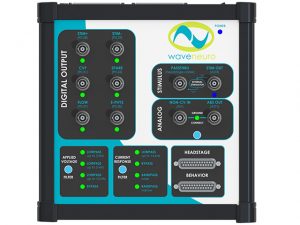
Description
The WaveNeuro Fast Scan Cyclic Voltammetry (FSCV) Potentiostat System is a unique electrochemical instrument you will not find from other traditional electrochemical suppliers. We are excited to bring high quality, regularly available, and uniquely designed neuroelectrochemical research products to you. Designed by FSCV scientists for FSCV scientists, the WaveNeuro is well-designed, of high quality construction, and supported by a company dedicated to supporting the instrument, as well as you the researcher. The WaveNeuro seeks to fill the gap that exists for commercial fast-scan cyclic voltammetry (FSCV) systems.
The WaveNeuro Potentiostat was designed for the scientist (neuroscientist, psychologist, physician, chemist, biologist, etc.) who seeks to study the link between the brain chemistry of electroactive species (such as monoamines, catecholamines like dopamine and serotonin, oxygen, peroxide, etc.) and physiology (such as structure, function, disease, neural transmission, etc.) and behavior (such as addiction, impulsivity, decision-making, etc.). Microdialysis, still a technique used in the field, can provide high spatial resolution for detection of these chemical species but offers poor temporal resolution. FSCV, as a technique, provides both high spatial and high temporal resolution. Coupled with carbon fiber microelectrodes, FSCV provides a well-established platform for in-vivo and in-vitro experimentation.
Traditionally, the products and instrumentation required to perform FSCV have only been available through scientific connections with developing laboratories. As the technique has grown in popularity, due in part to its relative ease of use, the availability of instrumentation has not followed the same trend. We are excited to bring such FSCV instrumentation to the market, thereby providing the robust technical, service, and sales support you have come to expect in the field of research instrumentation.
The WaveNeuro seeks to fill the gap that exists for commercial FSCV systems by providing systems with many novel features, such as:
- After official release, we will strive to have items in stock and ready to ship! Who can wait 8 weeks or more when your research productivity is on the line?
- A system that breaks from the past, with an overall updated design, including: a “breakout box” built into and included with the WaveNeuro, intuitive and clearly-labeled connectors, in a small dimensional footprint.
- Built for flexibility – includes behavioral input mapping to digital and analog input/output connections.
- Designed with Pine Research modular headstage cable design, preventing that “pile of unknown headstage/cables” that so many labs make over time.
FSCV Details
Pine Research currently offers working driven headstage amplifiers. In a working driven system, the reference electrode is grounded. The FSCV potential waveform (ramp) is connected to the non-inverting input of the operational amplifier, while the working electrode is connected to the inverting input. In this arrangement, the voltage at the microelectrode will follow the ramp applied to the inverting input.1
In this two-electrode configuration, current arising from electron-transfer reactions, such as the oxidation of dopamine, passes between reference and working electrodes. The measured current passes through the headstage amplifer, where it is converted to voltage, and sums with the the ramp voltage at the inverting input. Mathematically,
$latex V_O=-(i_{in}\times R_F)+V_R&s=2$
where is the output voltage, is input current, is feedback resistor (gain), and is the CV ramp voltage. By rearrangement, the signal voltage (proportional to the current across the feedback resistor in the headstage) is then
$latex (V_R-V_O)=i_{in}\times R_F=V_{signal}&s=2$
HDCV software, which supports the WaveNeuro FSCV Potentiostat system, performs software subtraction of the ramp according to this relationship, resulting in only the true differential current measurement.1
- Takmakov, P.; McKinney, C. J.; Carelli, R. M.; Wightman, R. M. Instrumentation for Fast-Scan Cyclic Voltammetry Combined with Electrophysiology for Behavioral Experiments in Freely Moving Animals. Rev. Sci. Instrum. 2011, 82, 74302.
R.M. Wightman et. al. have reported on this topic in depth If, after reviewing this document, you have any questions about our neuroelectrochemical research products, please do not hesitate to contact us.
Shop
Product Images
